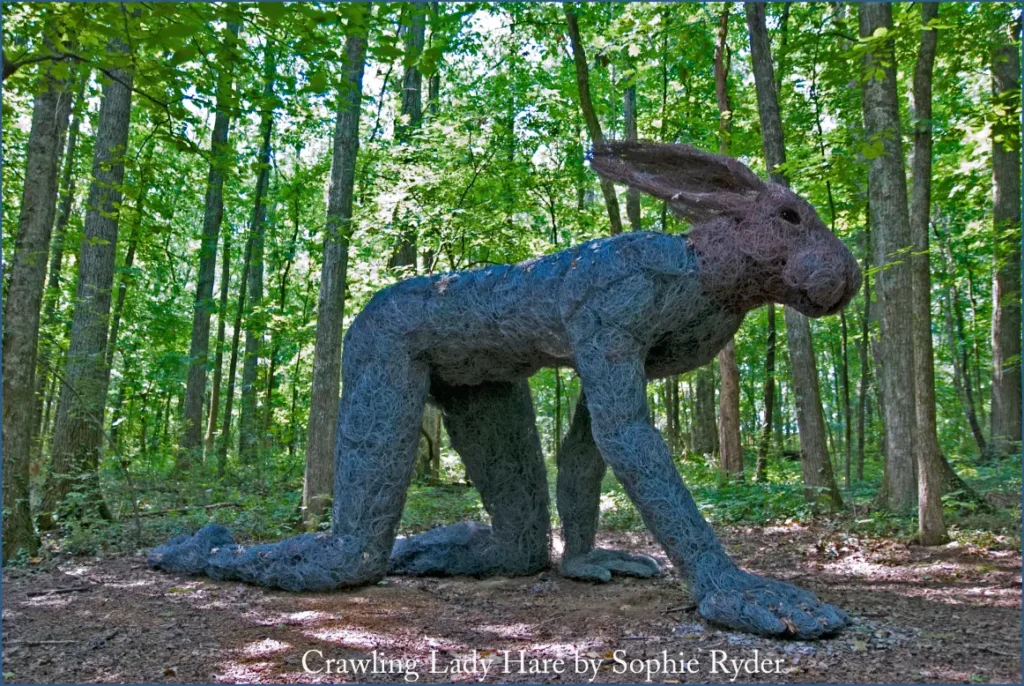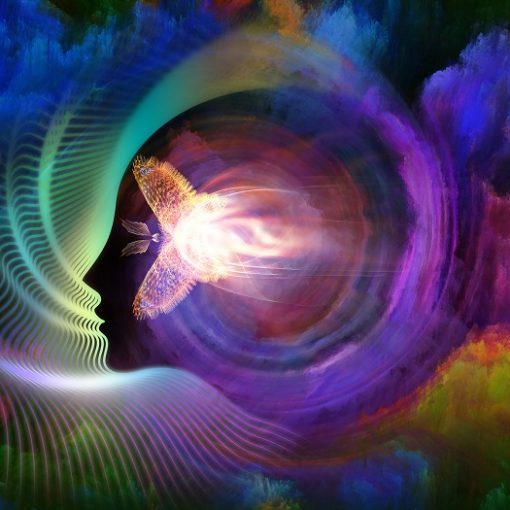
Reconnecting with Nature
Effective education must have a large experiential component, I said. Given the current critical imbalance between humans and other species, nature should be a primary area of experiential education. We should balance the abstractions of our classrooms with experiences of the wholeness of living, growing wild things. Following the centuries-old practice of shamans, students and their teachers should spend time in wilderness to restore direct awareness of the intricate interconnections that sustain life. Quiet time spent away from the elaborate constructions of our cities can help us gain the stillness in which we may hear nature’s voices.
Shamanic journeying also can lead to an intimate acquaintance with Nature. In his book The Adventure of Self-Discovery, psychotherapist Stan Grof reports that in the journeys he and wife Christina direct,8 many participants experience ‘complete and realistic identification’ with animals and plants and are given extraordinary knowledge of organic processes. In this mode of consciousness, ‘it is possible to gain experiential insight into what it feels like when a cat is curious, an eagle frightened, a cobra hungry, a turtle sexually aroused, or when a shark is breathing through the gills.’ This can lead to profound new understandings. ‘Subjects have reported that they witnessed botanical processes on the sub-cellular or molecular level’ and had ‘experiences of plant consciousness.’9
Grof commented that to speak of plant consciousness might seem ‘fantastic and absurd … to a traditional scientist.’10 He was writing in the late 1980s when biology was dominated by molecular geneticists, who, at the time, were supremely confident that all biological function was programmed by DNA sequencing. In the subsequent 20 years, however, there has been a conceptual revolution in genetics and cell biology, with the recognition that cellular networks in organisms are dynamic systems responding intelligently to changing external conditions, even modifying the structure of DNA where necessary. In his 2005 book, The Biology of Belief, cell biologist Bruce Lipton writes:
‘… each cell is an intelligent being that can survive on its own …. These smart cells are imbued with intent and purpose; they actively seek environments that support their survival while simultaneously avoiding toxic or hostile ones. Like humans, single cells analyse thousands of stimuli from the microenvironment they inhabit. Through the analysis of this data, cells select appropriate behavioral responses to ensure their survival. Single cells are also capable of learning through these environmental experiences and are able to create cellular memories, which they pass on to their offspring.’11
On the basis of such path-breaking research, Fritjof Capra concludes: ‘The organising activity of living systems … is mental activity …. Mind … is immanent in matter at all levels of life.’12
Shared Consciousness
We have already observed that this perception of universal consciousness is the crux of the shamanic worldview. By entering the eagle’s keen eye, the bear’s great strength, the herb’s healing power or the flame’s searing heat, the shaman shows us passageways to the spirit wisdom of natural forms. Shamans are shape-shifters, teaching that the boundaries between forms are not as impermeable as they may seem. Dramatically, this ancient knowledge that ‘there is no wall between species,’ rejected for three centuries by reductionist Cartesian science, has been rediscovered in this decade by molecular biologists. Lipton again:
‘Recent advances in genome science have revealed [that] living organisms … actually integrate their cellular communities by sharing their genes. It had been thought that genes are passed on only to progeny of an individual organism through reproduction. Now scientists realise that genes are shared not only among the individual members of a species, but also among members of different species. The sharing of genetic information via gene transfer speeds up evolution since organisms can acquire ‘learned’ experiences from other organisms. Given this sharing of genes, organisms can no longer be seen as disconnected entities; there is no wall between species.’13
‘It seems that every process in the universe that one can observe objectively in the ordinary state of consciousness also has a subjective experiential counterpart’ in altered states.14 This observation by Stan Grof suggests an important reason for the inclusion of shamanic practice in the educational curriculum. Shamanism gives working access to an alternative technique of acquiring knowledge. Although a pragmatic, time-tested system, it makes no claim to be science. Its strengths and limitations are different from those of the sciences and thus complement them. Being affective and subjective, shamanism offers another way of knowing.
Science as a Construct
In this it serves as shock therapy for students who have grown up with the unexamined belief that modern science is the only true path to knowledge. They have been taught that the scientific method is of a different order from all other human systems of understanding. The claim is that science, and only science, provides a clear window on reality and has the ultimate capacity to answer every question about nature. These assertions are untenable. Modern Western civilisation’s representation of reality is limited like that of every other civilisation. The sciences are cultural constructions to help us get by in the world. ‘A scientific theory is just a mathematical model we make to describe our observations,’ cautions Stephen Hawking. ‘It exists only in our minds.’15 Science is a simplification of the universe, which in its unfathomable vastness is always threatening to overwhelm the limited capacity of the human organism to comprehend. ‘I suspect there could be life and intelligence out there in forms we can’t conceive.’ observes Martin Rees, British Astronomer Royal. ‘It could be there are aspects of reality that are beyond the capacity of our brains.’16
Nonetheless, science reigns supreme and blinds most of our students, like the vast majority of us, to the diverse and richly varied paths to knowledge offered by other civilisations, contemporary and historic. ‘Today, the doors of the faerie hills remain sealed against us, for we keep the eyes of our mythic consciousness shut equally tight, refusing to allow cracks to appear in the walls of our present, desacralised world-view.’ The writer is Mara Freeman, whose field is Celtic and British folklore. ‘Few of us dare to open what W.B. Yeats called the ‘flaming door’ and explore the power that crackles on the thresholds of our reality structures. But to do so might send a revitalising current through the wasteland of our culture.’ Traditionally, Freeman says, it was shamans who had the courage and skill to throw open the ‘flaming door.’ ‘Those skilled in walking between the worlds knew how to harness the power of the threshold where the normal rules of time and space hang suspended.’17
Shamans are edge-walkers and shape-shifters, who dispel the illusion that all is fixed and orderly and controllable.
‘A stone’s throw out on either hand From the well-ordered road we tread, And all the world is wild and strange; Churl and ghoul and Djinn and sprite Shall bear us company to-night, For we have reached the Oldest Land Wherein the powers of Darkness range.’ – Rudyard Kipling18
Shamanism is an acknowledgment of the awesome spiritual powers that shape the universe. It is an acknowledgement that mystery will remain despite all our science and scholarship.
Let us encourage our students to delight in the permanence of the unknowable and to sit in reverence and awe before the majesty of the mysterious. Let us encourage them also to hear the message of the shamans that the moving force in the universe is spirit, which makes life possible and gives it meaning. The exhilarating news the shamans bring is that we are not alone. On a planet that is everywhere alive, conscious and inspirited, humans have many wise allies for counsel and aid. We should lay to rest our exaggerated fears that we do not have the resources to keep this show going. Equally, we must learn humility. The hubris of homo sapiens in claiming superiority over all other species has been the source of severe damage. Humanity is merely one spirit form among countless billions.
The smallest indivisible reality is, to my mind, intelligent and is waiting there to be used by human spirits if we reach out and call them in. We rush too much with nervous hands and worried minds. We are impatient for results. What we need …is reinforcement of the soul by the invisible power waiting to be used …. I know there are reservoirs of spiritual strength from which we human beings thoughtlessly cut ourselves off.’ — Henry Ford, Detroit News, 7 February 1926
John Broomfield is a teacher, writer, educational consultant and leader of cross-cultural study tours and shamanic workshops. Former Professor of History at the University of Michigan and President of the California Institute of Integral Studies, he is the author of Other Ways of Knowing: Recharting Our Future with Ageless Wisdom published by Inner Traditions. A student of sacred ecology and interspecies communication, he lives on remote land in the Marlborough Sounds, NZ, to learn directly from animals, plants and earth. His website is www.eagle-tours.co.nz and he is available at [email protected]
Notes
- Building on Stan’s earlier pioneering research with psychedelics, the Grof’s have developed a technique they call holotropic breathing to induce powerful altered states.
- Stanislav Grof: The Adventure of Self-Discovery: Dimensions of Consciousness and New Perspectives in Psychotherapy and Inner Exploration (Albany, SUNY, 1988) pp. 52-53 & 58-59
- Grof, op. cit., p. 59
- Bruce H. Lipton: The Biology of Belief: Unleashing the Power of Consciousness, Matter and Miracles (Carlsbad CA, Hay, 2005), pp. 37-38
- Fritjof Capra: The Hidden Connections (London, Harper Collins, 2002) p. 30. See also Evelyn Fox Keller: The Century of the Gene (Cambridge, Mass.; Harvard, 2000).
- Lipton, op. cit., pp. 44-45
- Grof, op. cit., p. 62
- Stephen W. Hawking: A Brief History of Time from the Big Bang to Black Holes (NY, Bantam, 1988) p. 139
- Telegraph.co.uk, 22 February 2010
- Mara Freeman: ‘The Flaming Door,’ Parabola, vol. 25, no. 1, February 2000, pp. 45-51
- Rudyard Kipling’s Verse: Inclusive Edition, 1885-1918 (London, Hodder & Stoughton,), pp. 575-576




